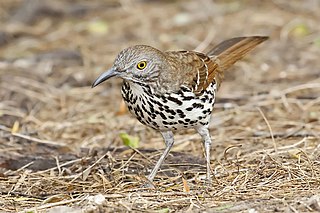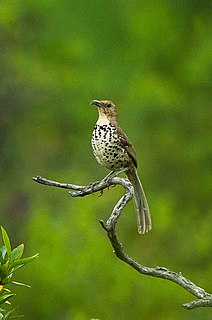 W
WToxostoma is a genus of bird in the family Mimidae. This genus contains most of the birds called thrashers, and accordingly members of this genus are sometimes referred to as the "typical thrashers".
 W
WThrashers are a New World group of passerine birds related to mockingbirds and New World catbirds. Like these, they are in the family Mimidae. There are 15 species in one large and 4 monotypic genera.
 W
WBendire's thrasher is a medium-sized species of thrasher native to the southwestern United States and northwestern Mexico. It is 23–28 centimetres (9.1–11.0 in) long, with a long tail and a medium-sized bill. Coloration is grayish-brown on its upperparts with paler, faintly dark streaked underparts. The base of the lower bill is often pale, the eyes are bright yellow, and the tips of the tail are white-tipped.
 W
WThe brown thrasher, sometimes erroneously called the brown thrush or fox-coloured thrush, is a bird in the family Mimidae, which also includes the New World catbirds and mockingbirds. The brown thrasher is abundant throughout the eastern and central United States and southern and central Canada, and it is the only thrasher to live primarily east of the Rockies and central Texas. It is the state bird of Georgia.
 W
WThe California thrasher is a large member of family mimidae found primarily in chaparral habitat in California and Baja California. It is the only species of Toxostoma throughout most of its range.
 W
WThe Cozumel thrasher is a bird from the mockingbird family (Mimidae), which is endemic to the island of Cozumel off the Yucatán Peninsula, Mexico. It is believed to be the most critically endangered species of bird in Mexico - if it indeed still exists, which is probable but not certain.
 W
WThe crissal thrasher is a large thrasher found in the Southwestern United States to central Mexico.
 W
WThe curve-billed thrasher is a medium-sized mimid native to most of Mexico and to the deserts of southwestern United States. It is a non-migratory species, and throughout most of its range it is the most common desert thrasher. Several subspecies have been classified since 1827, though there is no consensus on the number. Allopatric speciation is believed to have played a major role in the variations of the curve-billed. It is grey-brown overall with a slightly curved bill, and is similar in appearance to the related Bendire's thrasher. It generally resides in desert regions of the United States and Mexico, but can inhabit areas predominately populated by humans.
 W
WThe gray thrasher is a medium-sized passerine bird belonging to the family Mimidae. It is endemic to the Baja California peninsula of Mexico.
 W
WLeConte's thrasher is a pale bird found in the southwestern United States and northwestern Mexico. It prefers to live in deserts with very little vegetation, where it blends in with the sandy soils. LeConte's thrashers are nonmigratory birds that reside in the same territory annually. Although the species has been decreasing in certain areas of its range, in particular California, it still is abundant enough to not be considered for vulnerable status.
 W
WThe long-billed thrasher is a medium-sized resident songbird of South Texas and eastern Mexico. It bears a strong resemblance to its close relative the brown thrasher in appearance, calls, and various other behaviors; however, the two species do not overlap in range except in the winter when the brown thrasher will temporarily reside in the northern range of the long-billed.
 W
WThe ocellated thrasher is a species of bird in the family Mimidae. It is endemic to Mexico.